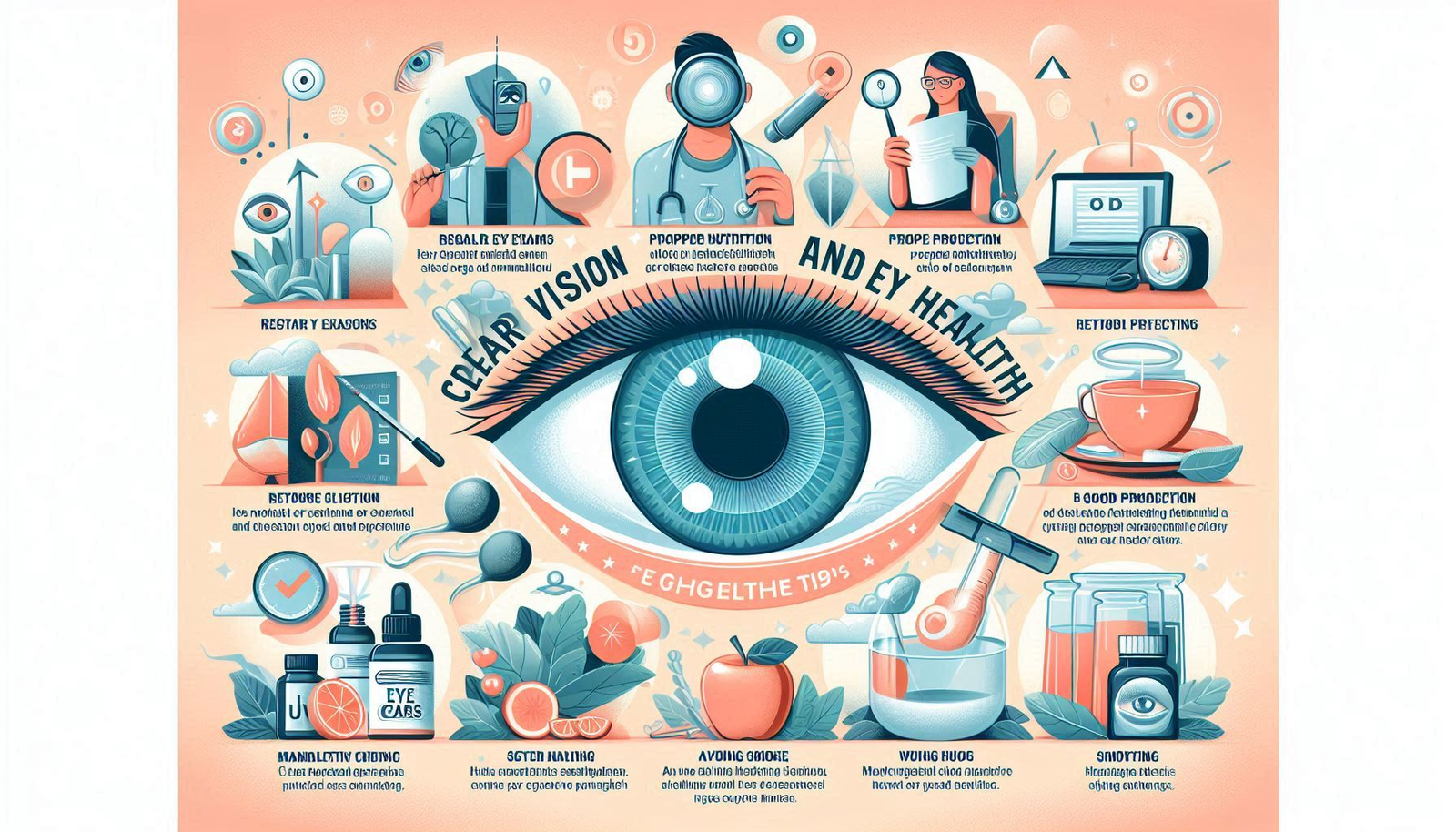
“10 Proven Tips for Clear Vision and Health
10 Proven Tips for Clear Vision and Eye Health
10 Proven tips for maintaining clear vision and healthy eyes in the digital age. Enhance your eye care routine today.
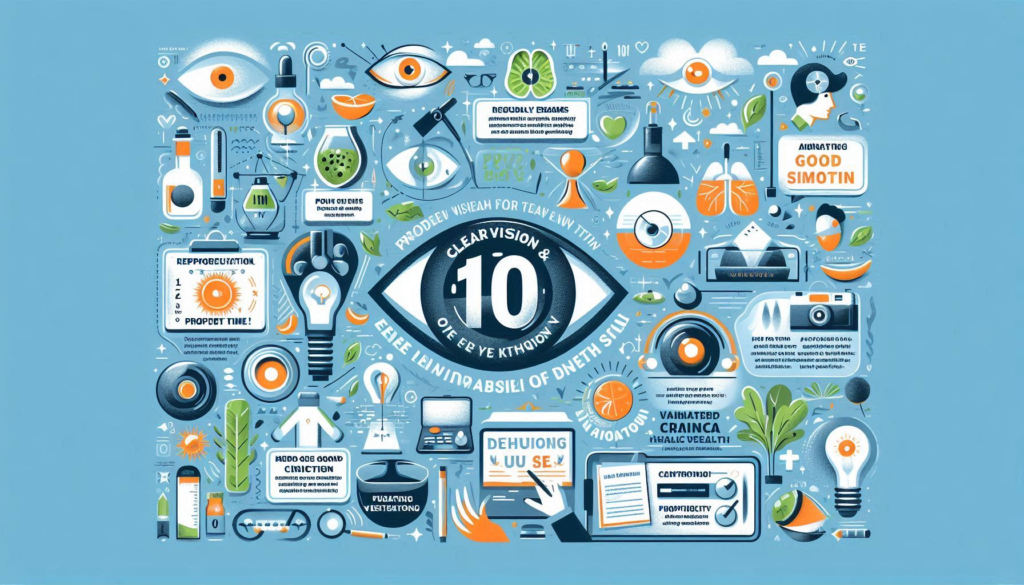
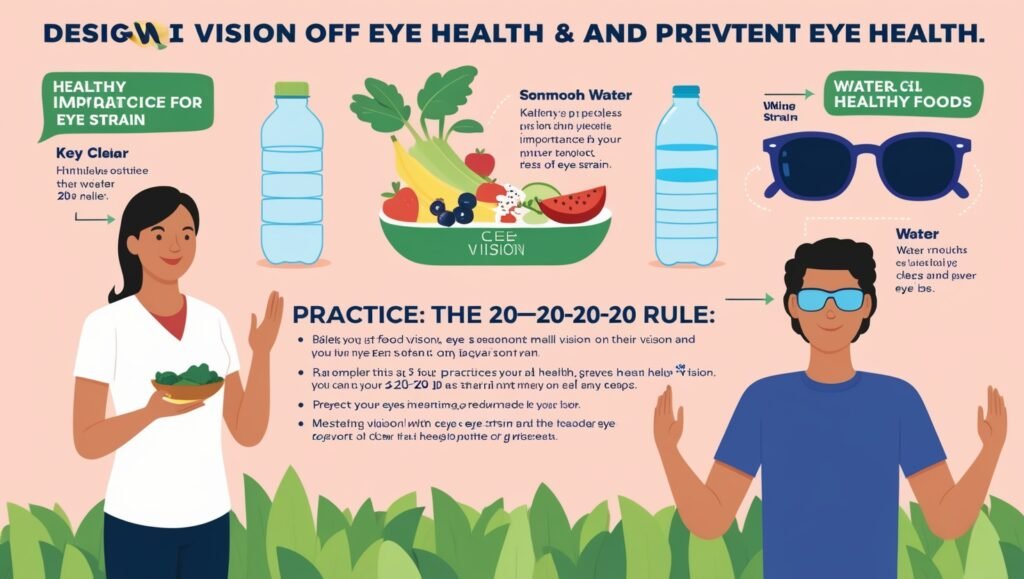
Introduction
Importance of Maintaining Clear Vision and Eye Health
Clear vision and eye health are essential for performing daily activities, from reading and driving to enjoying the beauty of the world around us. Maintaining good eye health ensures that we can continue to see clearly and avoid potential vision problems that can impact our quality of life.
Overview of Common Eye Issues and Their Impact on Daily Life
Common eye issues such as myopia (nearsightedness), hyperopia (farsightedness), astigmatism, and presbyopia can affect our ability to see clearly at different distances. Other eye conditions like cataracts, glaucoma, and age-related macular degeneration can lead to vision loss if not detected and treated early. These issues can make it challenging to perform everyday tasks, reduce independence, and affect overall well-being.
Brief Introduction to the 10 Proven Tips for Clear Vision and Eye Health
In this article, we will explore 10 proven tips to help you maintain clear vision and healthy eyes:
- Regular Eye Exams
- Proper Nutrition
- Protecting Eyes from UV Rays
- Reducing Screen Time
- Staying Hydrated
- Practicing Good Hygiene
- Using Proper Lighting
- Avoiding Smoking
- Managing Chronic Conditions
- Wearing Protective Eyewear
By following these tips, you can take proactive steps to protect your vision and ensure long-term eye health.
Section 1: Regular Eye Exams
Explanation of the Importance of Regular Eye Exams
Regular eye exams are crucial for maintaining eye health and detecting potential vision problems early. During an eye exam, an eye care professional can assess your vision, check for refractive errors, and examine the overall health of your eyes. This includes checking for signs of eye diseases such as glaucoma, cataracts, and macular degeneration.
Benefits of Early Detection and Prevention of Eye Diseases
- Early Detection: Regular eye exams allow for the early detection of eye diseases, which can be treated more effectively when caught early.
- Prevention: By identifying risk factors and early signs of eye conditions, eye exams can help prevent the progression of vision problems.
- Overall Health: Eye exams can also reveal underlying health issues such as diabetes and high blood pressure, which can affect eye health.
Recommended Frequency for Eye Exams Based on Age and Risk Factors
- Children: Children should have their first eye exam at 6 months, another at 3 years, and then before starting school. After that, regular exams every 1-2 years are recommended.
- Adults (18-60): Adults should have an eye exam every 2 years. Those with risk factors such as diabetes, high blood pressure, or a family history of eye disease may need more frequent exams.
- Adults (60+): Adults over 60 should have an eye exam every year, as the risk of eye diseases increases with age.
By scheduling regular eye exams, you can ensure that your eyes remain healthy and that any potential issues are addressed promptly.
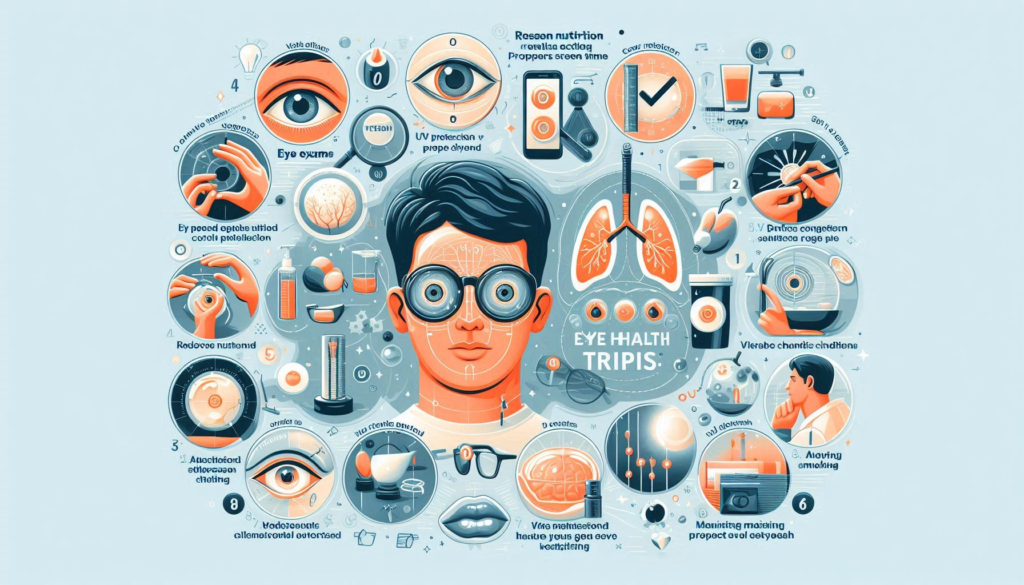
Read also: 10 Powerful Benefits of Mind-Body Balance
Section 2: Proper Nutrition
Explanation of How Diet Impacts Eye Health
A balanced diet plays a crucial role in maintaining eye health. The nutrients we consume provide the building blocks for healthy vision and help protect the eyes from damage caused by environmental factors and aging. A diet rich in essential vitamins and minerals supports the overall function of the eyes and can prevent or delay the onset of various eye conditions.
Essential Nutrients for Eye Health
- Vitamin A: Essential for maintaining the health of the retina and preventing night blindness. It also supports the function of the cornea.
- Vitamin C: An antioxidant that helps protect the eyes from oxidative stress and reduces the risk of cataracts.
- Vitamin E: Another powerful antioxidant that protects the eyes from free radical damage and may help prevent age-related macular degeneration (AMD).
- Omega-3 Fatty Acids: Important for maintaining the health of the retina and reducing the risk of dry eye syndrome. They also support overall eye health and function.
- Zinc: Helps transport vitamin A from the liver to the retina, where it is used to produce melanin, a protective pigment in the eyes.
Recommended Foods and Supplements for Maintaining Clear Vision
- Leafy Greens: Spinach, kale, and collard greens are rich in vitamins A and C, as well as antioxidants like lutein and zeaxanthin, which protect the eyes from damage.
- Carrots: High in beta-carotene, a precursor to vitamin A, which is essential for good vision.
- Citrus Fruits: Oranges, lemons, and grapefruits are excellent sources of vitamin C.
- Nuts and Seeds: Almonds, sunflower seeds, and hazelnuts are rich in vitamin E.
- Fatty Fish: Salmon, mackerel, and sardines are high in omega-3 fatty acids.
- Eggs: Contain lutein, zeaxanthin, vitamin E, and zinc, all of which support eye health.
- Supplements: Consider taking a multivitamin or specific supplements that contain the essential nutrients for eye health, especially if you have difficulty getting them from your diet.
Section 3: Protecting Eyes from UV Rays
Explanation of the Harmful Effects of UV Rays on the Eyes
Exposure to ultraviolet (UV) rays from the sun can cause significant damage to the eyes. UV rays can penetrate the eye and damage the cornea, lens, and retina. Prolonged exposure to UV rays increases the risk of developing cataracts, macular degeneration, and other eye conditions. It can also cause photokeratitis, a painful condition similar to sunburn of the eye.
Benefits of Wearing Sunglasses and Hats for Eye Protection
- Prevents UV Damage: Sunglasses with UV protection block harmful rays from reaching the eyes, reducing the risk of eye damage and related conditions.
- Reduces Glare: Sunglasses help reduce glare from reflective surfaces, improving visual comfort and clarity.
- Protects Delicate Skin: Wearing a wide-brimmed hat provides additional protection for the eyes and the delicate skin around them, reducing the risk of skin cancer and premature aging.
Tips for Choosing the Right Sunglasses with UV Protection
- Look for UV Protection: Choose sunglasses that block 100% of both UVA and UVB rays. Check the label to ensure they offer full UV protection.
- Consider Polarized Lenses: Polarized lenses reduce glare from reflective surfaces, making them ideal for activities like driving and water sports.
- Opt for Wraparound Styles: Wraparound sunglasses provide additional coverage and protect the eyes from UV rays entering from the sides.
- Check for Quality: Ensure the sunglasses meet safety standards and are made from high-quality materials. Cheap, low-quality sunglasses may not provide adequate protection.
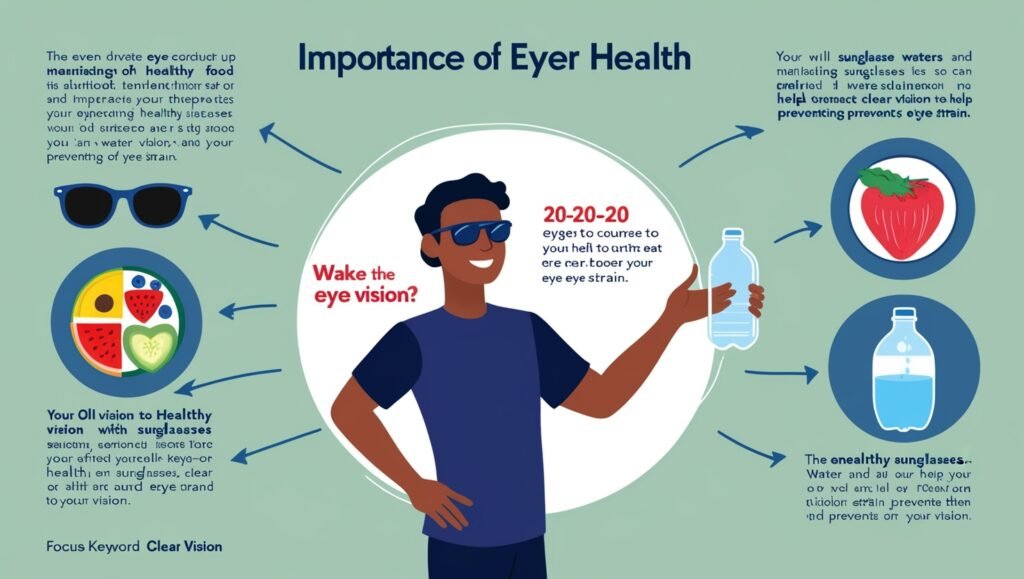
Section 4: Reducing Screen Time
Explanation of How Excessive Screen Time Affects Eye Health
Excessive screen time can lead to digital eye strain, also known as computer vision syndrome. Symptoms include dry eyes, blurred vision, headaches, and neck and shoulder pain. Staring at screens for prolonged periods reduces the blink rate, leading to dryness and irritation. The blue light emitted by screens can also disrupt sleep patterns and contribute to eye fatigue.
Benefits of Taking Regular Breaks and Practicing the 20-20-20 Rule
- Reduces Eye Strain: Taking regular breaks helps reduce the strain on your eyes, preventing discomfort and fatigue.
- Improves Focus: The 20-20-20 rule (every 20 minutes, look at something 20 feet away for 20 seconds) helps relax the eye muscles and improve focus.
- Prevents Dryness: Regular breaks encourage blinking, which helps keep the eyes moist and comfortable.
- Enhances Productivity: Short breaks can improve overall productivity by reducing eye strain and mental fatigue.
Tips for Reducing Screen Time and Protecting Eyes from Digital Strain
- Follow the 20-20-20 Rule: Set a timer to remind yourself to take breaks every 20 minutes.
- Adjust Screen Settings: Reduce screen brightness, increase text size, and use blue light filters to minimize strain.
- Maintain Proper Distance: Keep screens at an arm’s length (about 20-24 inches) from your eyes and position them slightly below eye level.
- Use Artificial Tears: If you experience dryness, use lubricating eye drops to keep your eyes moist.
- Limit Screen Time: Reduce non-essential screen time, especially before bedtime, to prevent digital eye strain and improve sleep quality.
Section 5: Staying Hydrated
Importance of Hydration for Eye Health
Staying hydrated is essential for maintaining overall health, including eye health. Proper hydration ensures that the eyes produce enough tears to keep them moist and comfortable. Dehydration can lead to dry eyes, irritation, and blurred vision.
Benefits of Drinking Enough Water for Maintaining Clear Vision
- Prevents Dry Eyes: Adequate hydration helps maintain the tear film, preventing dryness and irritation.
- Supports Eye Function: Water is essential for the proper functioning of the eyes, including the production of tears and the removal of debris.
- Reduces Eye Fatigue: Staying hydrated can help reduce eye fatigue and discomfort, especially during prolonged screen use.
Tips for Staying Hydrated Throughout the Day
- Drink Water Regularly: Aim to drink at least 8 glasses of water a day. Carry a water bottle with you to remind yourself to stay hydrated.
- Eat Hydrating Foods: Include water-rich foods in your diet, such as cucumbers, watermelon, and oranges.
- Limit Caffeine and Alcohol: Both caffeine and alcohol can dehydrate the body, so consume them in moderation and balance with water intake.
- Set Reminders: Use apps or alarms to remind yourself to drink water throughout the day.
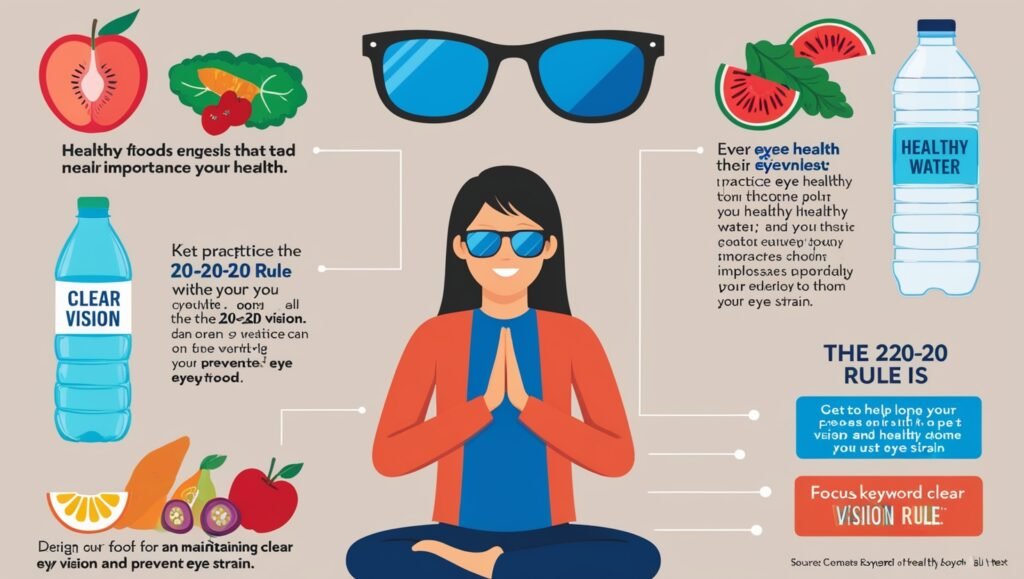
Section 6: Practicing Good Hygiene
Explanation of the Importance of Eye Hygiene
Practicing good eye hygiene is crucial for preventing infections and maintaining overall eye health. The eyes are sensitive and can easily become irritated or infected if not properly cared for. Good hygiene habits help protect the eyes from harmful bacteria and other contaminants.
Benefits of Keeping Hands and Contact Lenses Clean
- Prevents Infections: Keeping hands and contact lenses clean reduces the risk of eye infections such as conjunctivitis (pink eye) and keratitis.
- Reduces Irritation: Clean hands and lenses prevent the transfer of dirt and debris to the eyes, reducing irritation and discomfort.
- Maintains Clear Vision: Proper hygiene ensures that contact lenses remain clear and free from deposits, providing better vision.
Tips for Practicing Good Eye Hygiene to Prevent Infections
- Wash Hands Regularly: Always wash your hands with soap and water before touching your eyes or handling contact lenses.
- Clean Contact Lenses: Follow the recommended cleaning and storage instructions for your contact lenses. Use fresh solution each time and avoid using tap water.
- Avoid Rubbing Eyes: Rubbing your eyes can transfer bacteria and irritants, increasing the risk of infection.
- Replace Makeup Regularly: Replace eye makeup every 3-6 months to prevent bacterial growth. Avoid sharing makeup with others.
- Use Clean Towels: Use a clean towel to dry your face and avoid sharing towels to prevent the spread of bacteria.
Section 7: Using Proper Lighting
Explanation of How Lighting Affects Eye Health
Proper lighting is essential for maintaining eye health and preventing eye strain. Poor lighting conditions, whether too dim or too bright, can cause the eyes to work harder, leading to discomfort and fatigue. Inadequate lighting can also contribute to headaches and blurred vision, especially during activities that require prolonged focus, such as reading or working on a computer.
Benefits of Using Proper Lighting for Reading and Working
- Reduces Eye Strain: Proper lighting helps reduce the strain on your eyes, making it easier to focus on tasks without discomfort.
- Improves Visual Comfort: Adequate lighting enhances visual clarity and comfort, allowing you to see details more clearly.
- Prevents Headaches: Good lighting can help prevent headaches and eye fatigue caused by squinting or straining to see in poor light.
- Enhances Productivity: A well-lit environment can improve productivity by reducing the need for frequent breaks due to eye discomfort.
Tips for Setting Up an Eye-Friendly Lighting Environment
- Use Task Lighting: Use task lighting, such as desk lamps, to provide focused light for specific activities like reading or working. Position the light source to avoid glare and shadows.
- Adjust Ambient Lighting: Ensure that the overall ambient lighting in the room is sufficient to prevent sharp contrasts between the screen and the surrounding area. Use soft, diffused lighting to create a comfortable environment.
- Avoid Glare: Position screens and light sources to minimize glare. Use anti-glare screens or filters if necessary.
- Choose the Right Bulbs: Use bulbs with a color temperature of around 4000K to 5000K, which mimic natural daylight and reduce eye strain.
- Take Breaks: Even with proper lighting, it’s essential to take regular breaks to rest your eyes. Follow the 20-20-20 rule to reduce eye fatigue.
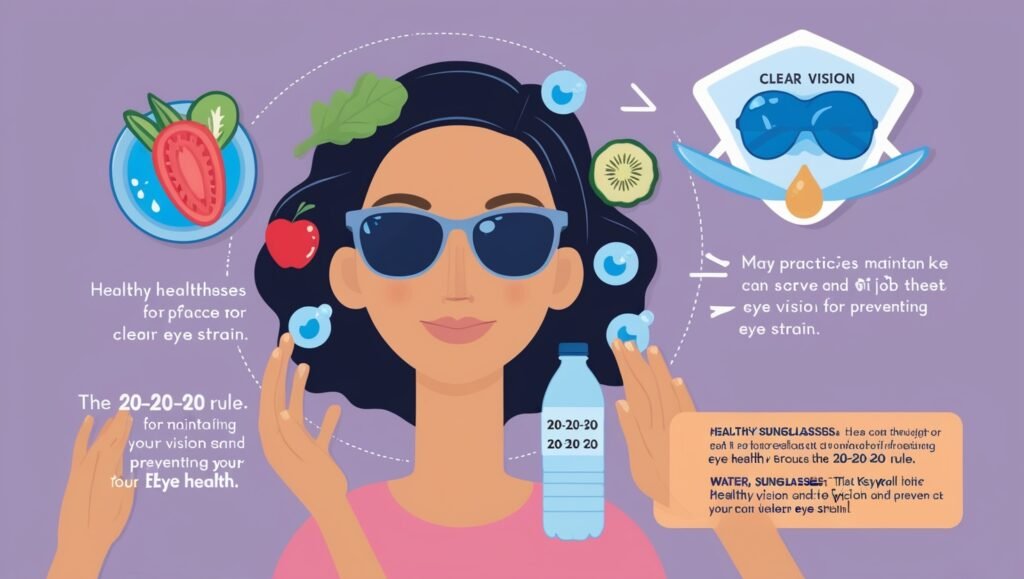
Section 8: Avoiding Smoking
Explanation of the Negative Effects of Smoking on Eye Health
Smoking has numerous negative effects on eye health. The harmful chemicals in tobacco smoke can damage the delicate tissues of the eyes, leading to various eye conditions and diseases. Smoking increases the risk of developing cataracts, age-related macular degeneration (AMD), and optic nerve damage, all of which can result in vision loss.
Benefits of Quitting Smoking for Maintaining Clear Vision
- Reduces Risk of Eye Diseases: Quitting smoking significantly reduces the risk of developing cataracts, AMD, and other eye conditions.
- Improves Blood Circulation: Stopping smoking improves blood circulation, ensuring that the eyes receive adequate oxygen and nutrients.
- Enhances Overall Health: Quitting smoking benefits overall health, reducing the risk of other chronic conditions that can indirectly affect eye health.
- Protects Vision: By quitting smoking, you can protect your vision and maintain clear eyesight for longer.
Tips for Quitting Smoking and Protecting Eye Health
- Seek Support: Join a smoking cessation program or seek support from healthcare professionals to help you quit smoking.
- Use Nicotine Replacement Therapy: Consider using nicotine replacement products such as patches, gum, or lozenges to manage withdrawal symptoms.
- Stay Active: Engage in physical activities to distract yourself from cravings and improve overall health.
- Avoid Triggers: Identify and avoid situations or activities that trigger the urge to smoke.
- Stay Positive: Focus on the benefits of quitting smoking, including improved eye health and overall well-being.
Section 9: Managing Chronic Conditions
Explanation of How Chronic Conditions Affect Eye Health
Chronic conditions such as diabetes and hypertension can have a significant impact on eye health. Diabetes can lead to diabetic retinopathy, a condition where high blood sugar levels damage the blood vessels in the retina, potentially causing vision loss. Hypertension, or high blood pressure, can damage the blood vessels in the eyes, leading to conditions such as hypertensive retinopathy and increasing the risk of glaucoma.
Benefits of Managing Chronic Conditions for Preventing Eye Diseases
- Reduces Risk of Eye Diseases: Proper management of chronic conditions can significantly reduce the risk of developing eye diseases associated with these conditions.
- Prevents Vision Loss: By keeping chronic conditions under control, you can prevent or delay the onset of vision loss and other complications.
- Improves Overall Health: Managing chronic conditions not only benefits eye health but also improves overall well-being and reduces the risk of other health issues.
Tips for Keeping Chronic Conditions Under Control to Protect Vision
- Monitor Blood Sugar Levels: If you have diabetes, regularly monitor your blood sugar levels and follow your healthcare provider’s recommendations for managing your condition.
- Control Blood Pressure: Maintain a healthy blood pressure through a balanced diet, regular exercise, and medication if prescribed by your doctor.
- Regular Check-Ups: Schedule regular check-ups with your healthcare provider to monitor and manage your chronic conditions effectively.
- Healthy Lifestyle: Adopt a healthy lifestyle that includes a balanced diet, regular physical activity, and avoiding smoking and excessive alcohol consumption.
- Medication Adherence: Take prescribed medications as directed by your healthcare provider to keep your chronic conditions under control.
Section 10: Wearing Protective Eyewear
Explanation of the Importance of Protective Eyewear for Certain Activities
Protective eyewear is essential for safeguarding your eyes during activities that pose a risk of injury or exposure to harmful substances. Activities such as sports, construction work, and laboratory experiments can expose your eyes to hazards like flying debris, chemicals, and intense light. Wearing protective eyewear helps prevent eye injuries and ensures that your vision remains intact.
Benefits of Wearing Safety Glasses and Goggles
- Prevents Eye Injuries: Safety glasses and goggles provide a barrier that protects your eyes from physical impacts, chemical splashes, and other hazards.
- Reduces Risk of Long-Term Damage: By preventing eye injuries, protective eyewear reduces the risk of long-term damage and vision loss.
- Enhances Safety: Wearing protective eyewear enhances overall safety during high-risk activities, allowing you to perform tasks with confidence.
Tips for Choosing the Right Protective Eyewear for Various Activities
- Identify the Hazards: Determine the specific hazards associated with the activity you are performing (e.g., flying debris, chemical exposure, UV light).
- Choose the Appropriate Type: Select protective eyewear that is designed to protect against the identified hazards. For example, safety glasses with side shields for impact protection, or goggles for chemical splash protection.
- Ensure Proper Fit: Make sure the protective eyewear fits comfortably and securely on your face. Ill-fitting eyewear can reduce its effectiveness and cause discomfort.
- Check for Certification: Look for protective eyewear that meets safety standards and certifications, such as ANSI Z87.1 for impact resistance.
- Maintain and Replace: Regularly inspect your protective eyewear for damage and replace it if it becomes scratched, cracked, or otherwise compromised.
Conclusion
Recap of the 10 Proven Tips for Clear Vision and Eye Health
- Regular Eye Exams: Keep your eyes healthy with regular check-ups.
- Proper Nutrition: Eat a balanced diet rich in essential nutrients for eye health.
- Protecting Eyes from UV Rays: Wear sunglasses and hats to shield your eyes from harmful UV rays.
- Reducing Screen Time: Take breaks and follow the 20-20-20 rule to prevent digital eye strain.
- Staying Hydrated: Drink plenty of water to keep your eyes moist and comfortable.
- Practicing Good Hygiene: Maintain good eye hygiene to prevent infections.
- Using Proper Lighting: Ensure proper lighting to reduce eye strain and improve visual comfort.
- Avoiding Smoking: Quit smoking to protect your eyes from damage.
- Managing Chronic Conditions: Keep chronic conditions under control to prevent eye diseases.
- Wearing Protective Eyewear: Use safety glasses and goggles to protect your eyes during high-risk activities.
Encouragement to Implement These Tips for Improved Scalp and Hair Health
By incorporating these tips into your daily routine, you can take proactive steps to maintain clear vision and healthy eyes. Each tip plays a crucial role in protecting your eyes from damage and ensuring long-term eye health.
Final Thoughts on the Importance of a Holistic Approach to Eye Care
A holistic approach to eye care involves addressing various aspects of your lifestyle, including diet, hygiene, and protective measures. By taking a comprehensive approach, you can ensure that your eyes remain healthy and your vision stays clear. Remember, your eyes are precious, so prioritize their health in your daily routine.
Conclusion
Recap of the 10 Proven Tips for Clear Vision and Eye Health
- Regular Eye Exams: Keep your eyes healthy with regular check-ups.
- Proper Nutrition: Eat a balanced diet rich in essential nutrients for eye health.
- Protecting Eyes from UV Rays: Wear sunglasses and hats to shield your eyes from harmful UV rays.
- Reducing Screen Time: Take breaks and follow the 20-20-20 rule to prevent digital eye strain.
- Staying Hydrated: Drink plenty of water to keep your eyes moist and comfortable.
- Practicing Good Hygiene: Maintain good eye hygiene to prevent infections.
- Using Proper Lighting: Ensure proper lighting to reduce eye strain and improve visual comfort.
- Avoiding Smoking: Quit smoking to protect your eyes from damage.
- Managing Chronic Conditions: Keep chronic conditions under control to prevent eye diseases.
- Wearing Protective Eyewear: Use safety glasses and goggles to protect your eyes during high-risk activities.
Encouragement to Implement These Tips for Maintaining Healthy Eyes
By incorporating these tips into your daily routine, you can take proactive steps to maintain clear vision and healthy eyes. Each tip plays a crucial role in protecting your eyes from damage and ensuring long-term eye health. Remember, small changes can make a big difference in preserving your vision.
Final Thoughts on the Importance of a Holistic Approach to Eye Care
A holistic approach to eye care involves addressing various aspects of your lifestyle, including diet, hygiene, and protective measures. By taking a comprehensive approach, you can ensure that your eyes remain healthy and your vision stays clear. Your eyes are precious, so prioritize their health in your daily routine. Embrace these tips and enjoy the benefits of clear vision and healthy eyes for years to come.
By incorporating these tips into your daily routine, you can take proactive steps to maintain clear vision and healthy eyes. Each tip plays a crucial role in protecting your eyes from damage and ensuring long-term eye health. Remember, small changes can make a big difference in preserving your vision. A holistic approach to eye care involves addressing various aspects of your lifestyle, including diet, hygiene, and protective measures. By taking a comprehensive approach, you can ensure that your eyes remain healthy and your vision stays clear. Your eyes are precious, so prioritize their health in your daily routine. Embrace these tips and enjoy the benefits of clear vision and healthy eyes for years to come.


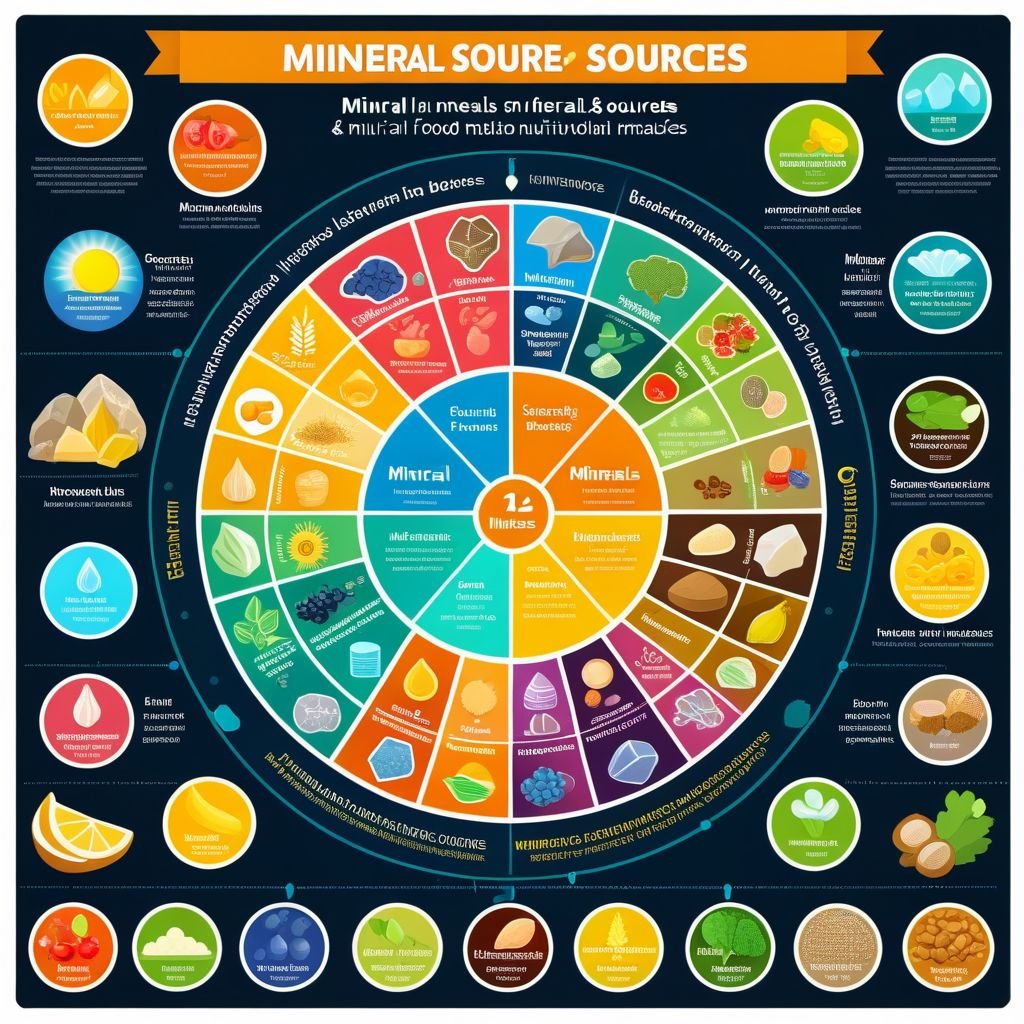
One Comment
Pingback: